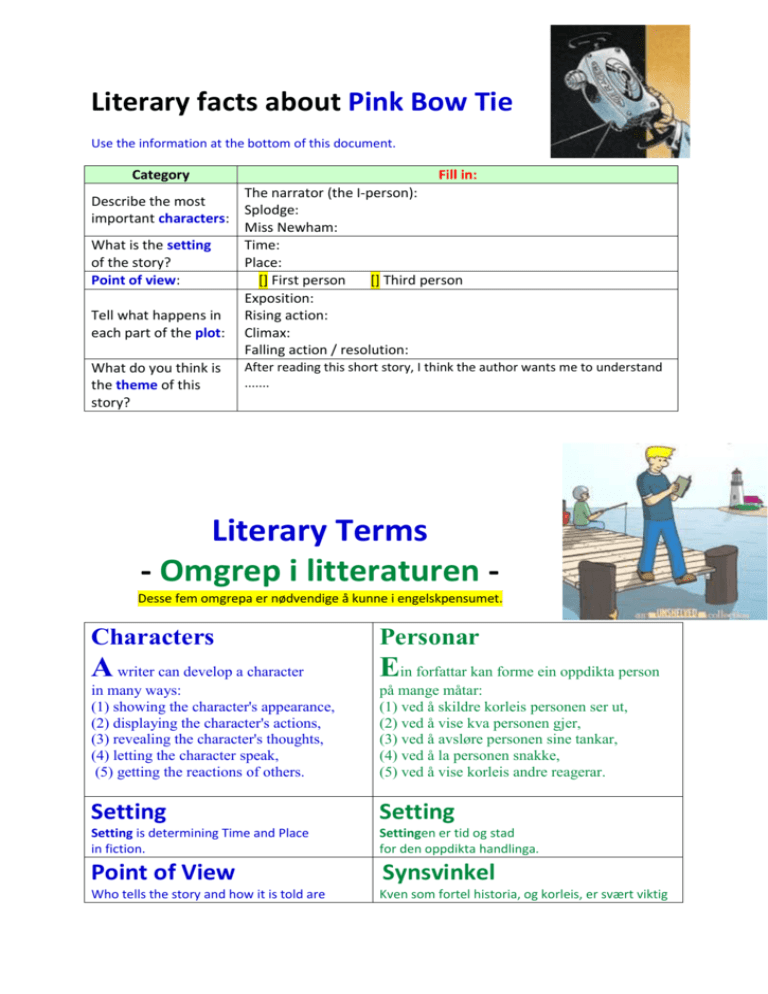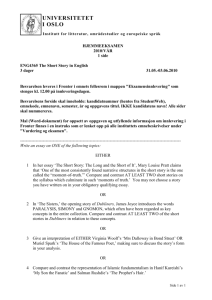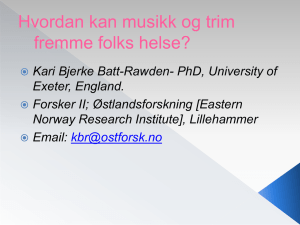Literary facts about Pink Bow Tie
advertisement

Literary facts about Pink Bow Tie Use the information at the bottom of this document. Category Fill in: The narrator (the I-person): Describe the most Splodge: important characters: Miss Newham: What is the setting Time: of the story? Place: Point of view: [] First person [] Third person Exposition: Tell what happens in Rising action: each part of the plot: Climax: Falling action / resolution: After reading this short story, I think the author wants me to understand What do you think is ....... the theme of this story? Literary Terms - Omgrep i litteraturen Desse fem omgrepa er nødvendige å kunne i engelskpensumet. Characters Personar A writer can develop a character Ein forfattar kan forme ein oppdikta person in many ways: (1) showing the character's appearance, (2) displaying the character's actions, (3) revealing the character's thoughts, (4) letting the character speak, (5) getting the reactions of others. på mange måtar: (1) ved å skildre korleis personen ser ut, (2) ved å vise kva personen gjer, (3) ved å avsløre personen sine tankar, (4) ved å la personen snakke, (5) ved å vise korleis andre reagerar. Setting Setting Setting is determining Time and Place in fiction. Settingen er tid og stad for den oppdikta handlinga. Point of View Synsvinkel Who tells the story and how it is told are Kven som fortel historia, og korleis, er svært viktig critical issues for an author to decide. The tone and feel of the story, and even its meaning, can change radically depending on who is telling the story. for forfattaren å ta stilling til. Tonen og inntrykket vi får av historia, til og med meininga med ho, kan forandre seg svært mykje, avhengig av kven det er som fortel. This angle of vision, the point of view from which the people, events, and details of a story are viewed, is important to consider when reading a story. Kva for ståstad og synsvinkel vi ser menneska, hendingane og detaljane frå, er viktig å merke seg når vi les ei forteljing. First Person Point of View [1st person = ”I”, or ”we”] In the first person point of view, the narrator (the I person) does participate in the action of the story. When reading stories in the first person, we need to realize that what the narrator is recounting might not be the objective truth. We should question the trustworthiness of the accounting. Første persons synsvinkel [Første person = ”eg”, eller ”vi”] Når det er første persons synsvinkel, deltek forteljaren (eg-personen) i handlinga. Når vi les forteljingar med første persons synsvinkel, må vi vere klar over at det forteljaren kjem opp med ikkje nødvendigvis er sakleg eller sant. Vi bør stille spørsmål ved om framstillinga er til å lite på. Third Person Point of View [3rd person = he / she / it / they] Here the narrator does not participate in the action of the story as one of the characters, (…). We learn about the characters through this outside voice. (The narrator says he / she / they about the characters). Tredje persons synsvinkel [Tredje person = han / ho / det / dei] Her deltek ikkje forteljaren i handlinga sjølv, men fortel om personane utanfrå. (Forteljaren seier han / ho / dei om personane). There are other points of view as well - see http://www.learner.org/interactives/literature/read/pov2.html Plot Plot Plot (conflict) is the struggle found in fiction. That struggle may be internal or external and is best seen in (1) Man in conflict with another Man: (2) Man in conflict in Nature; (3) Man in conflict with self. Plotet er den konflikten eller kampen som går føre seg i den oppdikta forteljinga. Det kan vere ein ytre eller indre kamp: (1) Mennesket i konflikt med andre; (2) Mennesket i konflikt med naturen; (3) Mennesket i konflikt med seg sjølv. The development of a narrative can be Utviklinga i handlinga kan uttrykkjast i eit outlined in a plot diagram: spenningsdiagram: Theme Tema Theme is the general idea or insight about life that a writer wishes to express. All of the elements of literary terms contribute to theme. A simple theme can often be stated in a single sentence. Temaet er den generelle ideen eller innsikta om livet som forfattaren ynskjer å uttrykkje. Alle dei litterære verkemidla bidrar til å skape temaet. Eit enkelt tema kan ofte uttrykkjast i ei einaste setning. "After reading (this book, poem, essay), I think the author wants me to understand ......." "Etter å ha lese (boka, diktet, stilen,) trur eg forfattaren vil ha meg til å forstå ......." See this presentation on theme: http://www.slideshare.net/jen.presley/literarytheme-review (Examples: go to slide no. 10). Dette oversynet er basert på http://www.tnellen.com/cybereng/lit_terms/ Der finn du fleire detaljar, og mange fleire litterære omgrep. A literary exercise in Tracks 1: Exercise 1b, page 176 - The Sniper Literary exercises in Tracks 2: TOPIC Point of view Setting Characters Theme Plot TEXT Pink Bow Tie A Drive in the Motor-Car Winners Butterflies An Honest Thief EXERCISE Exercise 6, page 23. Exercise 4, page 35. Exercise 6, page 94. Exercise 5, page 108. Exercise 5, page 125.


